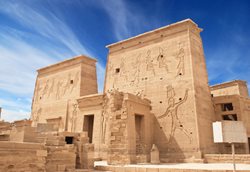
Egypt’s Temple of Philae can be overshadowed by the glamour of Abu Simbel and the grandeur of the High Dam of Aswan, but those in search of the mysteries of Ancient Egypt make Philae a priority, recognizing it the primary stronghold of the worship of the powerful ancient Egyptian Goddess Isis.
The temple(s) at Philae, including that to Isis, were built between 380-360 BCE and formerly stood on the Tropic of Cancer, the most northerly circle of latitude where the sun stands directly overhead during the summer solstice. The complex was carefully aligned to celebrate the solstice with a magnificent play of light and shade. For centuries the complex at Philae stood at the crossroads of a major thoroughfare between ancient Memphis and Meroe, terminating just short of the rapids of the First Cataract. Because the rapids could only be navigated at certain times of the year, Philae became not only an important religious center but also a strategic commercial hub, where goods were stored and traded during the off-season.
Philae was an important center of worship of the Goddess Isis and remained one long after Christianity took root and began to spread across Mediterranean. The Cult of Isis, also referred to as the Mystery Religion of Isis, was one of the oldest in Egypt and one which enjoyed considerable popularity across the ancient world, particularly in Rome, despite Emperor Augustus’s ban on all things Egyptian after his clash with Queen Cleopatra VII and Marc Anthony at Actium.
Isis is the Egyptian interpretation of the ancient Mother Goddess. She was the consort of the powerful god, Osiris, whose evil brother Set or Seth conspired to murder him by locking him in a coffin and drowning it in the Nile. To restore her husband, Isis disguised herself with ashes and rags and became a servant in the house of a wealthy lord; many scholars believe this is the origin of the classic fairytale, Cinderella. Isis brought her husband’s body back to Egypt, but Seth foiled her again by breaking the body into several pieces and scattering them around the land. Grieving again, Isis gathered the broken pieces and bound them together with a long, winding bandage (possibly the first Egyptian mummy). She then used the waters of the Nile to bring Osiris back to life, as well as giving life to her son, Horus, who avenges his father. This legend served as a metaphor for the return of spring and the all-important Nile flooding.
The central creed of the Isis Cult is the promise of life after death, or resurrection, with Isis playing a very active role in Osiris’s fate. She is “everywoman” in that her iconography is simultaneously that of a potent, dynamic, and proactive “Queen of Heaven,” as well as that of a grieving widow, and the loving mother of the young god Horus.
Isis worship enjoyed considerable popularity throughout the ancient world, particularly in Greece, Rome, and the outposts of the sprawling Roman Empire. Much of its appeal lay in its central promise of life everlasting, and in the intrigue of the secret rituals and ceremonies, including symbolic rituals of death and resurrection around the primary holidays of the cult. These happened in the early spring and on the 17th day of the month of Hathor, roughly corresponding to November 8th in the Julian calendar or October 31st in the modern Gregorian calendar. The autumnal holiday was an occasion to venerate the dead by lighting lanterns throughout the night.
If all this sounds vaguely familiar, it is thanks to the enduring appeal of the traditions of Isis worship. Isis's attributes and traditions were adapted and absorbed first into the pantheistic religions of Greece and Rome, where they became part of the worship of Ceres, the goddess of grain and harvest, and Artemis, the virgin goddess of the hunt. Ultimately Egypt’s compassionate mother and “Queen of Heaven” lent many of her attributes to the Virgin Mary.
Some non-traditional Biblical scholars have posited a theory that Jesus Christ may have been a secret initiate of the Cult of Isis, and that his crucifixion was an extreme form of the mysterious ritual death that was central to the Mystery Religion of Isis. As far-fetched as this may seem, the popularity of Isis worship at Philae did not abate until the 4th Century CE, when the Roman emperors took active measures to prevent it, removing many of the images of Isis from the walls of the temple complex. But Isis and her powerful message of hope of life everlasting endured.
Philae experienced its own resurrection in the 1960s. Construction of the Aswan Low Dam in 1902 regularly flooded the temples and covered them in Nile silt, both threatening irreparable damage to the temple complex. In the 1960s, UNESCO stepped in to lead a coalition of international archeologists and Egyptologists whose mission was to save the ancient monuments from the formation of Lake Nasser by the Aswan High Dam. Like Abu Simbel, Philae was dismantled into 40,000 pieces and moved to the safer location of the Island of Agilkia in the reservoir of the Old Aswan Dam, where travelers and devotees of ancient Egypt still come to learn about the legend of the Goddess Isis.
Visit the Temple of Philae and six other UNESCO World Heritage Sites including Abu Simbel on Alexander + Robert’s luxury Nile cruise,
Visions of Egypt aboard the aptly-named Oberoi-Philae. Always capped at 16 guests to ensure your maximum enjoyment. Speak to one of our knowledgeable reservation agents today!